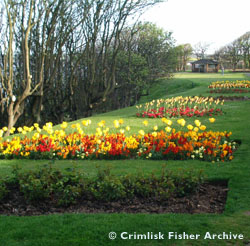 |
||||||||||||||||||||||||||||||||||||||||||||||||||||||||||||||||
|
||||||||||||||||||||||||||||||||||||||||||||||||||||||||||||||||
| ||||||||||||||||||||||||||||||||||||||||||||||||||||||||||||||||
Exploring Filey's Past - Supported by Filey Town Council  THE SANDS: THEIR SAFETY. THE SANDS: THEIR SAFETY.For more than five miles-until, indeed, the boulders at the base of Speeton Cliffs are reached-the bay is fringed with a broad belt of firm yellow sand-one of the greatest of Filey's glories, being absolutely safe for children to play upon, and affording splendid facilities for bathing, as for boating, in the gradually deepening water. It was upon this magnificent natural course that the first motor races on the seashore in Great Britain were run five years ago, and it is affirmed by experts that for firmness and freedom from shale, Filey Sands are preferable to those on the coast either of Florida or New Jersey. There are watering places by the dozen, seemingly snipped out from the same old cardboard pattern. The pattern may be a good one or it may be a bad one, but be it good or be it bad, they resemble in their featureless outlines the houses of a monotonous row in a city street. Visit one and you know them all, from the kitchen cellar to the attic. They have the same loose stretch of pebbly sea front, with the same long-legged pier, the same band in the same pavilion, the same theatre with the same assertive orchestra, playing the same pieces and the same refrains-the houses have the same glass knob on the same front door, and the same green box on the same grey sill. But there is only one Filey. Filey's chiefest charms are purely natural, but still Filey folk have the right of pride that they have completed what nature left unfinished. Standing about 200 feet above sea level, open to the sea, with the soil on which it stands naturally drained, it follows that Filey is as healthy as it is romantically situated. A perfect system of sanitation obtains, and the water supplied by the Council is exceptionally good. The death-rate is one of the lowest in England. The descent to "the Front" has been made easy in various points, one being by means of the Ravine, a lovely wooded gorge which, by the way, divides the North Riding of Yorkshire from the East Riding. A magnificent sea-wall and promenade, one of the best pieces of sea-wall construction to be found in England, has been built along the whole front of the town. Grass slopes rise from this breastwork to a second broad carriage road, facing which is a varied row of dainty marine villas and terraces of substantial residences. Filey does not vie with its more bustling neighbours in the provision of "attractions," as the term, in its limited sense, is applied to entertainments. It does not cater for those who seek distraction in the revolutions of Big Wheels and brass bands. Filey is distinctly quiet, and prides itself upon the fact. For all that, it is not dull. It possesses such varied sources of enjoyment that the holiday-maker's, or health-seeker's, or rest lover's call him what you will visit comes for him all too quickly to an end. The seashore stroll, the breezy cliff-top ramble, the country drives, the boating in the bay, the fishing from the Brigg; are all full of charm. There is an air of elegance about the town which stamps it with distinction. The noble prospect of wide stretching water, of towering cliffs, of beetling crag, and of rich green rolling landscapes which the town possesses, may have something to do with this subtle, undefinable sense of elegance, but it emanates from the town itself. The main thorough fares are broad avenues, well planted with trees; the roads and pathways are well kept, and indicate that Filey, though one of the most ancient sea-ports in Yorkshire, is abreast of the times in matters of local government. The houses are, architecturally good. The people are clear of skin, vigorous, and healthy, and the children are the chubby miniatures of their brawny elders. The older portion of the town-"Old Filey," as it is called where dwell mainly the fishermen and those others whose bread lies by, if not upon, the waters, is composed for the most part of solidly-built stone cottages, with thick walls, white limed, and presents a distinctly picturesque and Dutch-like appearance. The Crescent, on the south front, is generally reputed to be the finest block of mansions in Yorkshire. They are large without being aggressive, are all well kept, and, though simple in design, bear the indistinguishable stamp of opulence. They certainly have a view unrivalled on the coast. Before them are the Crescent Gardens, excellent specimens of the cliffside terraced lawns, with winding paths and shady trees. An orchestra plays here afternoon and evening, and vocal concerts are also given during the summer, the gardens being open to the public at a small charge. Filey is well provided with motor garages and livery stables, and as the country side is dotted with old-world villages, the town is a capital centre for anyone desiring to vary a seaside holiday with rural excursions. The town is in full telephonic communication with the whole of the National Telephone system. The Filey Urban District Council is a progressive body, owning the Gas and Water undertakings, and possessing, by virtue of a special Act of Parliament (1903), powers for governing traffic and regulating trade on the Sands. The building bye-laws, well-framed, are strictly enforced, and, as stated, the sanitary arrangements are excellent. The Council has its offices and chambers in a handsome red-brick building situate in Queen Street, where the Fire Brigade manual and rescue ladders are also located. Meetings are held monthly-on the first Tuesday, at six in the evening. This body is elected triennially in March-1913 being the occasion on which the members' term of office will next expire. Party politics do not enter into the question of the choice of candidates. This desideratum is not due to any lack of political conviction in the town, for Filey has both a Conservative and a Liberal Club-the former in Belle Vue Street and the latter over the Rocket Brigade House, in Mitford Street-each with a goodly membership. Both admit temporary members, an arrangement which is much appreciated by visitors on account of the excellent billiard tables the clubs possess. The affiliated Gymnastic Club s gymnasium in Mitford Street is open for the use of visitors who may care to become members during the period of their stay in the town. COLLECTION OF SEA-BIRDS' EGGS. The great sight of the Yorkshire Coast-if, indeed, not of the whole North East Coast of England-is undoubtedly that of witnessing the cliff-climbing for sea-birds' eggs at Bempton, near Filey. From May until the end of June climbing is in full swing, and on any day in those months men are to be seen dangling in a breeches-belt at the end of a line over the face of chalk cliffs which rise 400 feet sheer from the boiling surf below. The villages of Bempton, Buckton, and in a less degree, Flamborough, have long been the seat of this ancient industry, and owe not a little prosperity to its pursuit, and to the money spent by the numerous visitors who go either for the day or stay in the villages for longer periods, attracted by the fascination of this dangerous occupation. The men, hanging over the fearful abyss, are entirely dependent upon the fidelity of their fellows above-there are four in a gang: three above, and the man on the line-and on the strength of the rope. Naturally enough, this is always carefully examined before a descent is made, but the cliffs abound with flint, as keen in places as the edge of a razor, and strands at any moment may be severed. The climber keeps himself away from the face of the cliff by his feet, and signals by a hand-line when he wishes to be drawn up or lowered. Every moment his life hangs literally by a thread, and the mere view of him swinging at such a dizzy height is too much for most folks to witness unmoved. In all, five gangs, or crews, are employed-most of the men being climbers by long inheritance. The skill with which they swing themselves on to the narrow ledges on the cliff face is marvellous. Of birds and eggs there are hundreds of thousands. The guillemot predominates, with the razor-bill. puffin and kittiwake gull next in order. Singularlv enough, the herring gull, which abounds at the back of Filey Brigg, six miles north, is at Bempton never to be found; though, living contentedly amongst his marine friends, the blue rock pigeon is often to be met with. The jackdaw is an unwelcome but frequent visitor, for he commits fearful havoc amongst sea-birds' eggs. The egg of the guillemot averages four ounces, a remarkably heavy-one for a bird that seldom scales more than two pounds total weight. Occasionally, a double-yolked egg of six ounces is discovered, but such a specimen never finds its way to market. It goes to join the celebrated Filey collection which belongs to the veteran collector and naturalist, Mr. Joshua Fountain. So accustomed are the climbers to handling the eggs that it is seldom one is broken. They are safely placed, when gathered from the ledges, in a crossed haversack worn over the shoulders, packed in boxes when brought to the top and then despatched to London and elsewhere as a delicacy which, once tasted, is evermore desired. Some birds "sit tight " when the climbers appear, and have to be pushed off their eggs, but the vast majority wheel and flutter in great concern, shrieking and crooning in the weirdest of manners, and in that curiously plaintive way peculiar to oceanic fowls. Previous to the passing of the Act of 1880, and the subsequent enactments protecting the breeding birds, the number of those on the cliffs had become so much reduced by the slaughter on the part of so-called sportsmen, who shot the parents when their nesting duties tied them to the cliffs and made them an easy prey, that three men could not make half a crown a day at climbing. But now the birds have so increased that the full five crews, climbing regularly during May and Juno, make good wages, and in spite of this birds are continually on the increase, the number of eggs brought up the cliffs growing every year. The drive from Filey is a pleasant one, but the cliffs can also be seen from the decks of pleasure steamers, which in the summer months make daily trips from Scarborough and Bridlington.
|
||
site by Insight Design Solutions |
||
